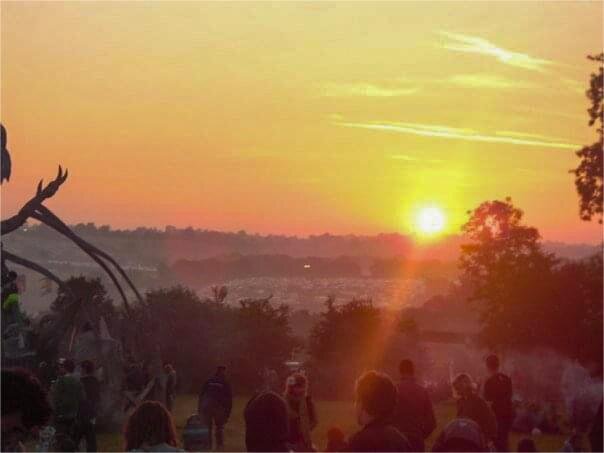“We are the music makers, we are the dreamers of dreams ”
I came of age in London, where music was my teenage blood and oxygen and all night dancing to electronic beats dawned in the early nineties. A new language of sound brought with it the worlds of its own making; worlds that shabbily stabled the technological marriage of harmony and melody, beats and reverb; the union of analogue and digital that myself and my peers knew we were born to interpret.
In a tidal wave of youth, how to distinguish what is emergent, when everything is emerging? We interpreted as listeners, dreamers, dancers, that would pollinate and spread this exciting intelligence through our young urban intermingling- panning as we were for the golden mean and all that glittered outside of inherited establishment. We learned to dance all night and walk the streets with sound.
Within this fledgling corpus of music, was not just the sensational buzz of infant techno, but the hallmark of art flashing glances of seminal beauty up against the sexy walls of of radical noise. A casting forth of cathedrals of sound, that spoke the architecture of the future into being while including the rhythm of the spatial divisions in the tendrils of plants. This sonic tincture was an elixir and we the honeybees, were catalysed and mobilized: by the drugs, the soft lasers falling gently into cloud like beds of dry ice, psychedelic tea parties that sailed mysteriously through the night. We sought out dark urban garrets, with neon ornaments where sound held court ‘til dawn. Fermenting unity with strangers on the dancefloor before confronting the bizarre ordeal of the grimy first Tube.
These Eleusinian mysteries (that fell within my GCSE year) climaxed when, lured from our urban beds and haunts, in the full archetypal grace of midsummer, we entered into an inpromptu ceremony at the temple of Avalon, on unconcreted land - when Orbital played Glastonbury Festival in 1994. The pulse of Gaia, who had whispered to us in the melodies and sampled vocals that thread this music, addressed us in the open fields. In the arena of star and dew we danced away the constrictions of redundant reality, and fastened to a love which now seeped into us from the soil beneath us; there the whispered communion that had been promised in the music, was made real.
" According to Plato, "the ultimate design of the Mysteries ... was to lead us back to the principles from which we descended, ... a perfect enjoyment of intellectual [spiritual] good.” Thomas Taylor
Orbital, named after the motorway which was key to the underground rave scene were delivering their new album, the as yet unheard Snivellisation. 40,000 people converged on the main stage field on Saturday night. A gang of exuberant pilgrims, myself and friends, were effervescent with anticipation, and we a cluster like so many other clusters came to web together as audience into one shifting, musing sea of messy reverie. Within the blurry night, roiling and indistinct, the Hartnoll brothers gleamed in their magi box; signalling the unfolding of this rite. It was like a sound lab come living room that extended out upon an existential horizon, and spoke to faith within apocalyptic destruction. Gladly we danced, we gave up our bodies to the beats, the kykeon was flowing in its various eclectic forms. The crowd responded to the layers of sound like a lapping tide, kinetically knit into response while the detritus of a despondent world scene floated in the electrical crackle of the visuals on the stage.
Afterwards, blown in the megastorm of it all, I knew that something had taken place, in the unmappable new material, which was unprecedented. I looked to the others for witness, we vowed we would find it in the new album when it was released; this was the only way back to that moment of something like grace, something seismic which had altered the terrain somewhere, someplace that was unlocatable.
The Orbital song Are We Here temples a climax and resolution within the territory of existential question and apocalyptic threat. As this new song had lit up the field, gathering pace with the roughshod galloping break beats we moved in this vista of enlivened tension delighted by the new material. The unexpected serving of the climax that bore us into the “higher love” that the female vocals of Alison Goldfrapp had prophesized struck into the intelligence of my heart and seared through a collective wasteland like the harbinger of true peace. Me, my friends, the audience, humanity – whatever. A conglomerate of dissolvable labels forming a mass of redeemed freedom and love. Something like that. Persephone was out from the Underworld and crowned in summer in our hearts, and they, the Magi had struck the chime.
Jeremy Deller, in his gem of a film which is stashed on YouTube “A secret history of England 1983 – 1993”, skillfully outlines the radical uncontrived politics of rave subculture in the early 90’s. The groundswell in this youth movement, that brought people out of the cities in droves and into the fields to dance was a fusion of sound system culture with the traveller scene. Therein was a potency and creativity that was resistance made manifest in celebration. Here the threads of ancient and modern mingled in Ceredwyn’s cauldron and the drops of inspiration flew wide. Orbital’s music is born of that inspiration and holds this signature of the call of mythic earth and redemption, with the electronic sculpting and finesse that heralded a new way entirely. They shared their sermons of electronic solace for the vast congregation to come and through penetrating into the mainstream this could continue even after the more radical movement had been curtailed. That night at Glastonbury was when they breached the central vessel of music culture, and for myself, when something sublime, that was more than that song, and the ecstasy and the festival and my friends, something was sown that fulfilled the sense of the mystery rite. What exists in that confluence of events and circumstances I feel still holds so much understanding yet to come.
As this rupture into freedom was plastered over with the Criminal Justice Bill, and a funnelling of popular culture into newly marketed alcopops and BritPop; the potency was assimilated, diverted and solidified, and Parklife became the enclosed domain of the outdoors. But the radical force that caused the swell, where does that reside exactly, and will it come again, now freedom is being challenged so overtly in so many dimensions of our lives? Does this moment have a message for the youth of today, and can the seeds of inspiration within it be broadcast and take root in multigenerational soil?
Returning from Glastonbury that year I continued to find expression of this higher impulse in the IDM music that fructified in the wake of the free party scene. Aphex Twin’s various ambient works mapped the seasons of my life, becoming the core text through which life sense could be made. In the tumult of adolescent learning as teenage realisations struck through friendships, alliances and innocence, this body of music remained the trellis upon which growth was assured and homework could be completed.
In the city, the pleasure of night riding a bus on the upper deck with a carefully crafted walkman mixtape illumined the true, the good and beautiful into the map of London. Each section of cityscape was talismanic of this hopeful future with its glyphs of architecture and lights. The dark gleaming Thames formed the mystic visuals in the city of promise. Intersections of flyovers were the cerebral vertebrae of the ancient world as sound pulses wed inner and outer dimensions into a continuous display of light and form. The music a technological prescription, that merged harmony with street value, and encoded it with meaning and purpose.
Looking back, there was no friction around malignant technological advance, the shadow of surveillance and data collection unforeseen; we were Steven Spielbergs children - technology had not yet cut its zombie teeth. What we felt in the pulse of this new manoeuvre was freedom and evolution, and it hearkened to something cyclic in its linkage to land and nature. In the intelligent dance music which emerged from this scene there remains a fusion, where technology and hope and organic experience are not sundered. Female vocals siren the mythic timbre, weaving euphoria and inclusive spaciousness within the architectures of modern possibility.
Somewhere in this fertile landscape, we; the ones who bridged analogue and digital, found nectar upon the intersection, and danced for joy- and it was good.
Everybody in the Place - An Incomplete History of Britain 1984- 1992 is artist Jeremy Deller’s fascinating recapitulation of the dance scene in the 80’s and 90’s.

![" According to Plato, "the ultimate design of the Mysteries ... was to lead us back to the principles from which we descended, ... a perfect enjoyment of intellectual [spiritual] good.” Thomas Taylor](https://images.squarespace-cdn.com/content/v1/5bed568f25bf0211cfcd551b/1626023338764-726VNGDVDRSUUOLGQIV8/Eleusinian01.jpeg)







